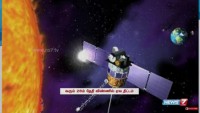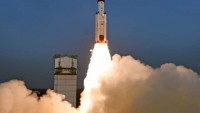Isolated Stars Can Be Weighed: New Method
| Darlene Tverdohleb | | Oct 07, 2015 08:30 AM EDT |
(Photo : VideoFromSpace) A young and powerful pulsar is discovered by gamma ray scope, emitting a beam of light.
University of Southampton's mathematicians have just found a new method in measuring isolated stars that exist on their own spaces --- the so-called young pulsars.
Nature World Report said that until recently scientists merely measured the mass of stars, moons, and planets by studying their motion in relation to nearby ones using the gravitational pull between the two as their basis in the calculations.
Like Us on Facebook
Dr. Wynn Ho at the University of Southampton said that they have discovered this new method, which is using the principles of nuclear physics rather than gravity to work out on what the mass is for pulsars, which is an exciting breakthrough that has the potential to revolutionize the old kind of calculation.
On the other hand, Dr. Cristobal Espinoza, from the Pontificia Universidad Catolica de Chile, noted that pulsars in isolation can be weighed by using a different technique although the previous but precise measurements of pulsar masses were made for stars that orbit another object.
However, young pulsars sometimes experience some glitches where they find the chance to speed up for only a brief period of time. They emit a rotating beam of electromagnetic radiation that can be detected by telescopes from Earth when the beam sweeps like that of a lighthouse. Hence, the new method is used.
As also reported by Immortal News, Dr. Ho collaborated that resulted this breakthrough with Dr. Nils Andersson, a professor of applied mathematics at the same university as the former is affiliated to, and Dr. Danai Antonopoulou from the University of Amsterdam as well as Dr. Espinoza.
With their new method, the glitch can be ignored. To cite as an example for the glitch, one can imagine the pulsar as a bowl of soup. It is spinning at one speed while the soup is spinning faster. The friction between the inside of the bowl and its content causes the bowl to speed up. Hence, the more soup there is inside the bowl, the faster the bowl will spin.
With their results they provide an exciting new link between laboratory work in both high-energy and low-temperature physics and the study of distant astronomical objects.
The star-weighing method is a perfect example of interdisciplinary science that Dr. Ho referred to as their new breakthrough.
The researchers have published their findings in the Science Advances journal.
Tagsisolated stars, young pulsars, nuclear physics, gravitational pull, electromagnetic radiation
©2015 Chinatopix All rights reserved. Do not reproduce without permission
EDITOR'S PICKS
-

Did the Trump administration just announce plans for a trade war with ‘hostile’ China and Russia?
-

US Senate passes Taiwan travel bill slammed by China
-

As Yan Sihong’s family grieves, here are other Chinese students who went missing abroad. Some have never been found
-

Beijing blasts Western critics who ‘smear China’ with the term sharp power
-

China Envoy Seeks to Defuse Tensions With U.S. as a Trade War Brews
-

Singapore's Deputy PM Provides Bitcoin Vote of Confidence Amid China's Blanket Bans
-

China warns investors over risks in overseas virtual currency trading
-

Chinese government most trustworthy: survey
-

Kashima Antlers On Course For Back-To-Back Titles
MOST POPULAR
LATEST NEWS
Zhou Yongkang: China's Former Security Chief Sentenced to Life in Prison

China's former Chief of the Ministry of Public Security, Zhou Yongkang, has been given a life sentence after he was found guilty of abusing his office, bribery and deliberately ... Full Article
TRENDING STORY

China Pork Prices Expected to Stabilize As The Supplies Recover

Elephone P9000 Smartphone is now on Sale on Amazon India

There's a Big Chance Cliffhangers Won't Still Be Resolved When Grey's Anatomy Season 13 Returns

Supreme Court Ruled on Samsung vs Apple Dispute for Patent Infringement

Microsoft Surface Pro 5 Rumors and Release Date: What is the Latest?












